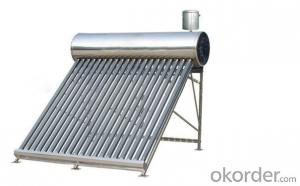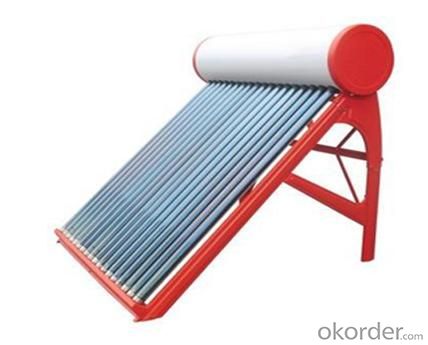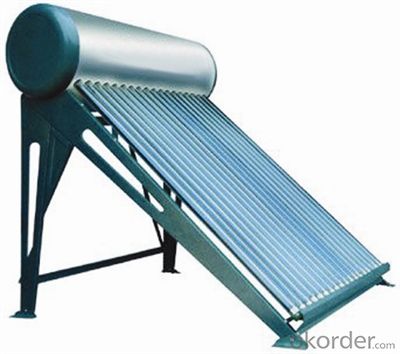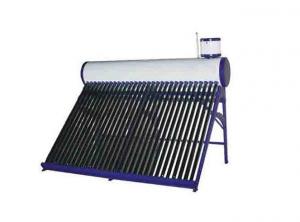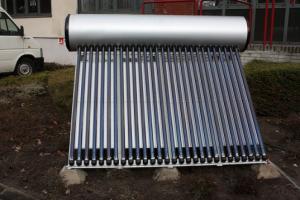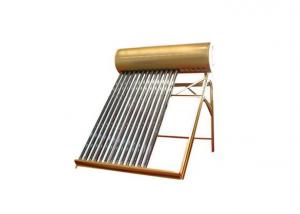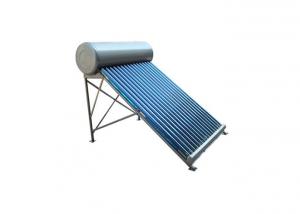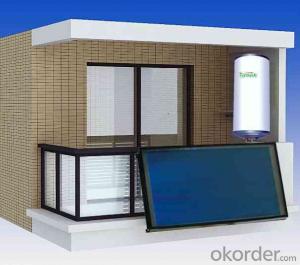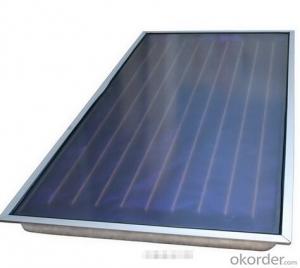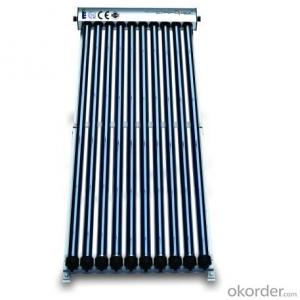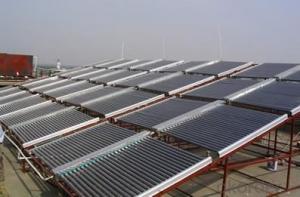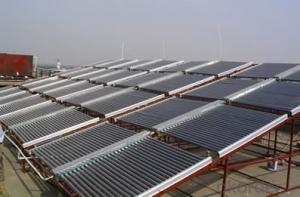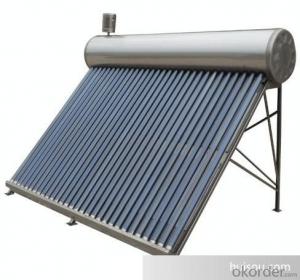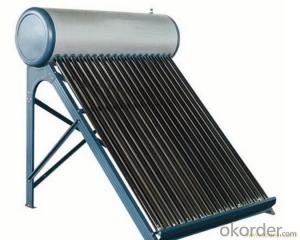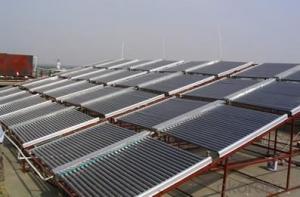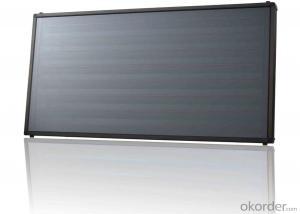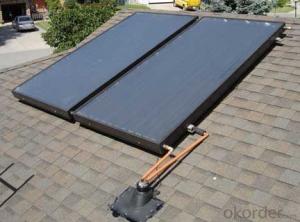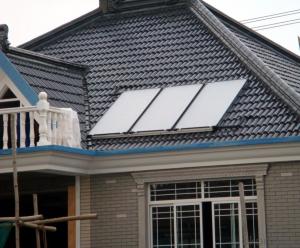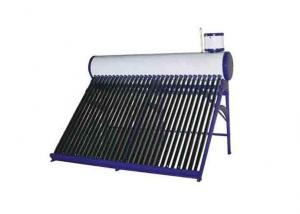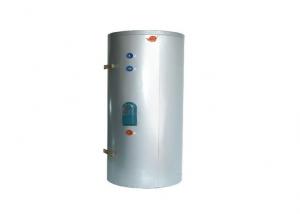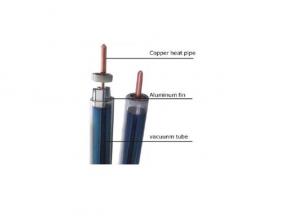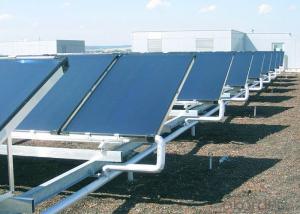2024 New Design Tower Solar Collectors Solar Water Heater System
- Loading Port:
- China main port
- Payment Terms:
- TT OR LC
- Min Order Qty:
- 1 set
- Supply Capability:
- 6000 set/month
OKorder Service Pledge
OKorder Financial Service
You Might Also Like
Introduction of Non-Pressure Solar Water Heater:
Non-pressure Solar Heater is one of the most economical solar water heating device with pretty high efficiency at the same time. It consists of hot water storage tank, solar vacuum tubes with mouth plug in storage tank, and bracket supporting tank and tubes.When cold water in evacuated tubes is heated with solar irradiation, as the specific gravities of hot water and cold water are different, hotter water goes upward to storage tank and colder water goes downward to glass tubes. through this continuous circulation, the cold water in storage tank will be gradually heated till sunset.
Specialty:
1. High thermal performance and working temperature: the heat exchanging rate even in winter can up above 55%.
2. Heat collecting efficiency is at least 20% above common solar systems.
3. Work in all day and all season: no matter any corner of the world, this system can work well even -40℃ to avoid the tube freezing problem.
4. Reliability: No water following through the tube, so water scale can not generate and tube cracks could be avoided, the system still can keep working even with some damaged tubes.
5. It can connect with water tap and work automatically with pressure0.6Mpa, bring enjoyable washing experience.
6. Safety: P/T valve would release pressure and temperature to protect tank..
Technical Specification:
1. Outer tank material: SUS304 stainless steel or powder coated color steel
2. Inner tank material: 1.2mm thick SUS304 food grade stainless steel ( Optional material SUS316L)
3. Vacuum tube material: borosilicate glass 3.3; AL-SS-CU absorb coating, with copper heat pipe inside
4. Frame material: 1.2mm thickness stainless steel
5. Insulation material: 55mm thickness polyurethane
6. Suitable for mains pressure water(up to 8 bar/116psi)
7. Easy plug-in installation
8. Install the T/P valve on the pressurized tank
9. Seal material: Stabilized High Temperature Silicon
Outer tank material: SUS304 stainless steel or powder coated color steel
Inner tank material: 1.2mm thick SUS304 food grade stainless steel ( Optional material SUS316L)
Vacuum tube material: borosilicate glass 3.3; AL-SS-CU absorb coating, with copper heat pipe inside
Frame material: 1.2mm thickness stainless steel
Insulation material: 55mm thickness polyurethane
Suitable for mains pressure water(up to 8 bar/116psi)
Easy plug-in installation
Install the T/P valve on the pressurized tank
Seal material: Stabilized High Temperature Silicon
19. Vacuum Tube | 20. Size (mm) | 21. Φ47*1500 / Φ58*1800 / Φ70*2100 | |||||
22. Tube (pcs) | 23. 10 / 12 / 15 / 18 / 20 / 22 / 24 / 30 / 36 / 42 | ||||||
24. Material | 25. Borosilicate 3.3 glass, magnetron spluttering selective coating | ||||||
26. Coating | 27. Single-target AL-N/AL or Three-target AL/N-Cu-SS | ||||||
28. Water Tank | 29. Capacity | 30. 80L ~ 500L for hot water storage tank | |||||
31. Inner tank | 32. Food-grade stainless steel SUS304-2B / SUS316 | ||||||
33. Insulation | 34. High-density polyurethane foam with 70~80 hour heat preservation | ||||||
35. Tank shell | 36. Food-grade stainless steel SUS304-2B | ||||||
37. Bracket | 38. Shaped strong aluminum alloy structure adaptable for flat or slope roof | ||||||
39. Accessories | 40. Anti-aging silicon seals, Dustproof seals, Air-vent cap, Stainless screws | ||||||
41. Auxiliary Devices | 42. Assistant tank, Intelligent controller, Electrical heater, Magnesium anodes | ||||||
43. Tilt Angle | 44. 25 ~ 50° | ||||||
45. Water Output | 46. 45 - 95°C | ||||||
47. Hail Resistance | 48. Φ25mm diameter | ||||||
49. Model Number | 50. Solar Vacuum Tube | 51. Tank 52. Liter | 53. System 54. Liter | 55. Container Loading Qty /sets | |||
56. Size /mm | 57. Qty /pcs | 58. 20GP | 59. 40GP | 60. 40HQ | |||
61. VNS-58SA12-100 | 62. Φ58*1800 | 63. 12 | 64. 100 | 65. 132 | 66. 58 | 67. 119 | 68. 140 |
69. VNS-58SA15-130 | 70. 15 | 71. 130 | 72. 170 | 73. 54 | 74. 108 | 75. 131 | |
76. VNS-58SA18-150 | 77. 18 | 78. 150 | 79. 198 | 80. 43 | 81. 86 | 82. 105 | |
83. VNS-58SA20-170 | 84. 20 | 85. 170 | 86. 223 | 87. 40 | 88. 80 | 89. 97 | |
VNS-58SA24-200 | 24 | 200 | 263 | 35 | 70 | 85 | |
VNS-58SA30-250 | 30 | 250 | 329 | 28 | 56 | 68 | |
VNS-58SA36-300 | 36 | 300 | 395 | 23 | 47 | 57 | |
Product Show
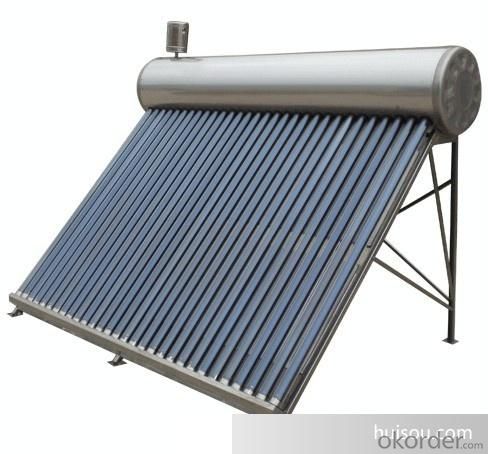
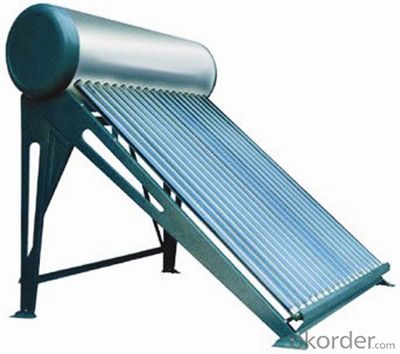
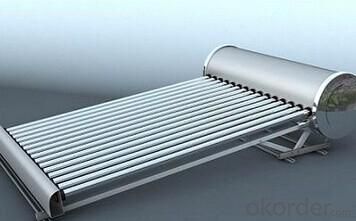
Our Services
1. OEM service
2. Warranty: 5 years
3. Considerable after sale service
Color steel Compact pressure Thermal solar heater
FAQ:
1. What’s the delivery time?
10 days after receiving deposit.
2. How long is the warranty?
5 years for whole system, 1 year for accessory
3. What’s your production capacity?
6000sets/month
4. What’s the MOQ?
1 set.
5. What’s your payment term?
Container: 30% T/T in advance for deposit, 70% T/T before shipment for fist order.
70% T/T after seeing copy of B/L from second order
Sample: 100% T/T in advance
Other choices: L/C at sight.
6. What certifications do you have?
CE, SOLAR KEYMARK, SRCC and etc.
- Q: Can solar collectors be used for industrial purposes?
- Yes, solar collectors can be used for industrial purposes. They can provide an efficient and sustainable source of energy for various industrial processes such as heating, cooling, and powering machinery. Solar thermal collectors can effectively harness the sun's energy and convert it into heat, which can be utilized in industrial applications. Additionally, photovoltaic solar collectors can generate electricity that can be used in various industrial operations. The use of solar collectors in industries contributes to reducing reliance on traditional fossil fuel-based energy sources and helps in achieving sustainability goals.
- Q: Can solar collectors be used for heating swimming pools in summer?
- Yes, solar collectors can be used for heating swimming pools in summer. Solar collectors absorb the sun's energy and transfer it to the pool water, effectively raising its temperature. This can be a cost-effective and environmentally friendly way to heat swimming pools during the summer months when there is abundant sunlight available.
- Q: Can solar collectors be used for generating electricity on robots?
- Yes, solar collectors can be used for generating electricity on robots. Solar panels or collectors can be integrated into the design of robots to capture sunlight and convert it into electrical energy. This can be a sustainable and efficient way to power robots, especially in outdoor or remote environments where traditional power sources are not readily available.
- Q: Can solar collectors be used for heating industrial wastewater?
- Heating industrial wastewater can be achieved using solar collectors. These collectors can harness the sun's energy and transform it into heat, which has multiple applications, including water heating. Various reasons, such as treatment, sterilization, or maintaining specific temperature requirements, demand the heating of industrial wastewater. To supplement or replace traditional heating methods, solar thermal collectors can be integrated into the wastewater treatment system. They can pre-heat the wastewater before it enters the treatment process, thereby reducing the energy consumption of conventional heating systems. Moreover, solar collectors can help maintain the desired temperature of the wastewater throughout the treatment process, minimizing the need for additional energy inputs. The use of solar collectors for heating industrial wastewater presents several benefits. Firstly, it decreases reliance on fossil fuels and diminishes the emission of greenhouse gases associated with conventional heating methods. Secondly, it can lead to significant cost savings in terms of energy consumption. Lastly, solar thermal systems have a lengthy lifespan and require minimal maintenance, making them a dependable and sustainable solution for heating industrial wastewater. Nevertheless, it is crucial to consider various factors, such as sunlight availability, wastewater treatment system size, and specific temperature requirements, when assessing the viability of using solar collectors for heating industrial wastewater. A thorough analysis of these factors should be conducted before implementing solar thermal systems for this purpose.
- Q: Can solar collectors be used for heating water in freezing temperatures?
- Yes, solar collectors can be used for heating water in freezing temperatures. However, the efficiency of the collectors may be reduced in extremely cold conditions, and additional measures such as insulation and antifreeze solutions may be required to prevent freezing and ensure optimal performance.
- Q: Can solar collectors be used for greenhouse heating?
- Yes, solar collectors can be used for greenhouse heating. Solar collectors can capture and convert sunlight into thermal energy, which can then be used to heat the greenhouse. This sustainable and renewable energy source can help maintain optimal temperatures for plant growth and reduce reliance on traditional heating methods.
- Q: Can solar collectors be used for heating buildings?
- Yes, solar collectors can be used for heating buildings. Solar collectors, such as solar thermal panels or solar water heaters, can harness the sun's energy to heat water or air, which can then be used for space heating in buildings. This renewable energy source can help reduce reliance on traditional heating systems and lower carbon emissions.
- Q: Can solar collectors be used in hurricane-prone areas?
- Yes, solar collectors can be used in hurricane-prone areas with proper design and installation considerations. The collectors should be securely mounted to withstand strong winds and potential debris impact. Additionally, regular maintenance and inspection will help ensure their functionality and durability in such challenging weather conditions.
- Q: How do solar collectors impact water pollution?
- Solar collectors have a positive impact on water pollution as they do not contribute to it. Unlike traditional energy sources such as coal or natural gas, solar collectors generate electricity by harnessing the energy of the sun, which means they don't emit any harmful pollutants or greenhouse gases into the atmosphere. Water pollution often occurs as a result of the pollution generated during the extraction, transportation, and burning of fossil fuels. These pollutants can contaminate water sources through processes like acid rain or runoff from power plants. Solar collectors, on the other hand, do not produce any emissions that can contribute to water pollution. Furthermore, the production and installation of solar panels involve minimal use of water resources. Unlike fossil fuel power plants that require large amounts of water for cooling purposes, solar collectors have no such water requirements, making them even more environmentally friendly. In summary, solar collectors have a positive impact on water pollution by reducing the emissions of pollutants into the atmosphere and minimizing water usage, making them a clean and sustainable energy source for the planet.
- Q: Can solar collectors be used for generating electricity on tablets?
- No, solar collectors cannot be used for generating electricity on tablets as they require a larger surface area to capture sufficient sunlight and convert it into electricity. Tablets do not provide enough space for effective solar energy generation.
Send your message to us
2024 New Design Tower Solar Collectors Solar Water Heater System
- Loading Port:
- China main port
- Payment Terms:
- TT OR LC
- Min Order Qty:
- 1 set
- Supply Capability:
- 6000 set/month
OKorder Service Pledge
OKorder Financial Service
Similar products
Hot products
Hot Searches
Related keywords
